 Story – Christopher Hector Photos – Roslyn Neave and archives
Story – Christopher Hector Photos – Roslyn Neave and archives
Susanne Miesner is one of the special treasures we try to re-visit every time we go to Germany. Susanne is that rarest of creatures – an equestrian theorist and author who can actually ride and who has the results on the board to prove it. Usually the ones with the most elegant turn of phrase, are nowhere on the scene when it gets to the nitty gritty ‘get on the horse and show us what you can do’, bit.
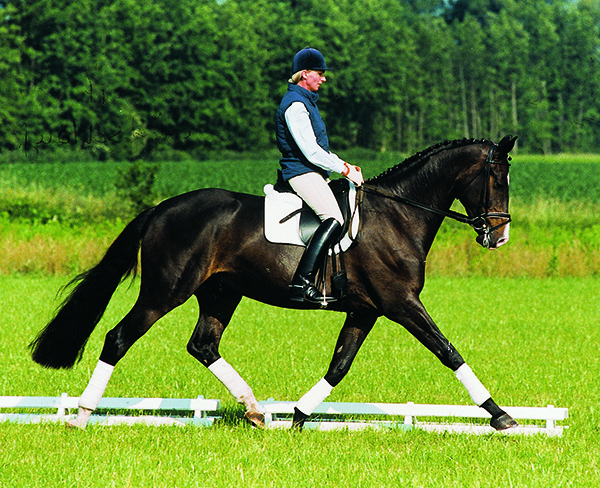
No armchair theorist – Susanne Miesner and Ronaldo…
The other thing that makes any visit to Wietelshof a joy, is that Susanne has one of those minds that is always ticking over – while as a lecturer and author she is a stalwart defender of the Classical Principles, her message is always fresh and bright as she absorbs and processes new information.
For example, who would have thought that the relative equestrian backwater of the former East Germany might emerge as the home of the German classical principles?
“A few months ago, I was in East Germany, and you would expect that in East Germany, riding is not that fundamental. When The Wall fell down, the late Paul Stecken, Michael Rash who was then the head of the Germany Riding Academy and I, we drove to East Germany to look at all the Studs, and conduct examinations to test if their riders were as good as the riders in the west of Germany.”
“It was an adventure. East Germany was in horrible shape. We went to the four big studs and it was amazing, thirty years ago everybody was riding the same. One had more talent, one had less, but they all used the same riding methods. Thirty years later when I went again to what is now called the New Germany, I was amazed, again. In my seminar I had about eight horses, there were about 150 people in attendance, and it was still the same, because the trainers in that part of Germany, teach the same methods – always on the classical principles. And the horses were great – I mean they weren’t fantastic Bundeschampionate horses, but they were well ridden, the riders all understood the training scale. They knew that the most important things are rhythm and relaxation. It was so much fun.”
“It was a five hour drive to get home, but I was so delighted that I’d seen this group of completely different horses, all at different levels, but the riders all had the same ideas.”
And it is in the rich and prosperous Western part of Germany, that Susanne sees the principles under threat…
“When I do seminars here – in the Western part of Germany where I live – I feel they are all training using different methods.”
And those different methods cause their own problems…
“At the same time we have veterinary clinics going up all over the country, but the real pros, they have the vets coming to their stables. When you go to those prestige vet clinics, it is amazing how many pleasure horses get treated there. There are a lot of good pleasure horse riders, who think because I am not doing anything on the horse, just sitting and riding through the woods, my horse must be happier. But there are at lot of those horses in the vet clinics because they have the same problems – and I think this is because there is a lack of understanding of the basics. When you ride a horse, the horse needs to learn to carry the rider. The horse is not born as an animal that can carry weight, the rider has to educate the horse, and many of these people don’t understand that.”
Susanne points to the contradiction – the horses have improved, but has the dressage?
“Think about it, we breed so many fantastic horses and where are they? We have about ten or fifteen great horses in Rio, fantastic riding – the top ten were just superb, but where are the rest? I personally think that the wisdom, the understanding, of classical dressage, that you have to build up a horse over the years, in a logical plan, has been lost for many riders. You might get away with doing something different with one horse, but with twenty, thirty horses, if you don’t have that basic knowledge you won’t get away with it. You need to understand the biomechanics.”
The problem shows itself in the form of contact – or lack of it…
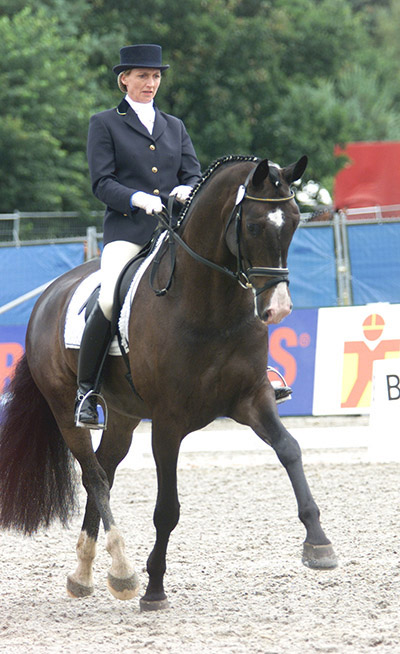
“Everyone can see when a horse is not in good rhythm, when it is not relaxed, but the understanding of the good connection is the bridge to all the work that follows. Connection is the bridge to impulsion, to straightness, true collection – not the Anky van Grunsven collection, which was never collection, even Totilas never had collection, connection is the bridge to the goals of the Training Scale.”
“The older I get, the more the training scale gets into me – for instance last night, I was holding another seminar, and I had six completely different riders, and they were all so happy this morning, sending me SMS messages, and that is just because I spent 20 minutes telling them, ride your horses from behind into the connection. It’s not just letting go, letting go, letting go, and riding the horse on the forehand, you have to be able to make a link between the hind leg, the topline, and the mouth and then back from the mouth to the hind leg. And then the front leg will improve, because anyone who is in balance can dance much better.”
“There’s another important element. One of my dearest friends is still Richard Weiss, who taught me so much about the seat and the influence from the rider to the horse.”
“What is so important in our riding, be it training level or Grand Prix level, dressage, jumping, eventing, whatever you do, you have to watch both sides, you have to watch the horse, but you also have to watch the rider, and you must get the two together in harmony. When human beings are dancing they can talk to each other, but in riding you have one being with a horizontal vertebrae, four feet on the ground, a long neck, and it cannot think, and a rider who has to do the thinking. A horse cannot think logically, it follows its instinct – that’s why I don’t like the people who say, my horse came out of the box today and he really wanted to work… That’s not what a horse does. The other being has two legs on the ground, has a very small neck, and that being can think, and the two have to work together. So how much harder is riding than dancing?”
“We have in Germany today, classic dressage, and it is very good in dressage, as in any sport, to have developments in technique, in the structure of the sport. Look at the horse shows now, and they have changed so much in terms of the prize money, the spectators, the changes are phenomenal, but what hasn’t changed is how to train the horse, the balance of the horse has never changed, the instinct of the horse has never changed. We can develop better saddles, better bridles, better horses even, but for the better horses you need better riders.”
more follows
“The better horses sometimes lack balance and they need a longer time. But while we should welcome development, it is important that we don’t get too influenced by those new ideas. particularly some of the new ideas that come from people who really don’t know what they are talking about, who have never ridden a horse. Sure it is good for riders to use things like physiotherapy, Ludger Beerbaum does that, but not to use these things as a tool, to try and change the horse.”
“I had another interesting experience recently when I went with my friend Anja Frömming to Ireland. We go there every second year as assessors for their trainers. This time, for the first time, we were working with Prix St Georges trainers. On the first day they had four people showing us how to prepare for a Prix St Georges test, and then they rode the test. Everybody was tense and tight because the assessors were sitting there, and all they did was work on movements of the Prix St Georges test, and the tests were kind of mediocre.”
“After that we had a briefing with them all – good horse people – and we just gave little hints – did you see the problem in the walk? did you see the problem in the connection? And those pupils they all came back the next day and worked on what they needed with their horses, they all worked on rhythm, relaxation, connection, impulsion, and the horses were so fantastic that really I had goose bumps!”
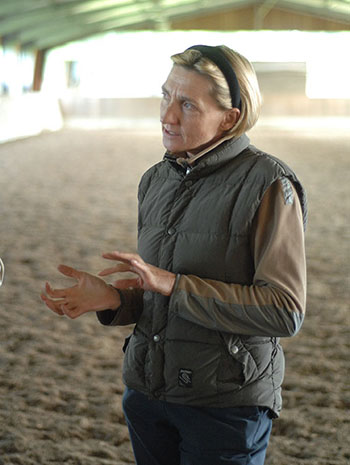
“What I am trying to say is that if people understand the basics of classical dressage, this is not only the most important thing for people to have fun riding horses, but also for the welfare of horses – and in Europe we have a big problem with the welfare of the horses and the animal rights people, many of whom don’t think you should even ride a horse, why would you put a bit in a horse’s mouth?”
“Anja Frömming told me on the trip to Ireland that there is now a special girth with some sort of special knobs on it – €1300 – how crazy! And the problem is the kind of people who buy these things, these special tools, are the people who cannot ride. There is a mega-wave of ‘experts’ who want to tell us how to ride instead of going back to the roots and asking, what is rhythm? what is relaxation? what is connection?”
“What was very interesting at the seminar I gave last night, it was not a big seminar, maybe 100 people, but there was a young girl on a pony, the pony was very nice, but the girl had really stiff hands. I asked her a couple of times to soften her hands, but it did not work, so I said to myself, forget about correcting the girl, work on the pony. I got him going forward, coming back, working on the rhythm and after twenty minutes the pony was really in rhythm, and you know what? Her hands were perfect because the pony let her sit, and she relaxed and it was easy for her hands to go soft and to the correct position. Riding can be so easy if you have a horse that gives you the feeling, I can be part of you. That’s why I so often compare dancing and riding. The best dancer in the world can’t dance with someone who is stiff and can’t follow the movements.”
“What is the training scale in Australia? Is it rhythm/ relaxation or is it suppleness? When I lived in America, there was always a discussion – what is relaxation? What is suppleness? In Germany we have this word, lossgelassenheit. But on one side we have ‘los’, very loose and relaxed, and on the other side we have ‘tension’ but what people don’t realise is that in the middle we have suppleness. I think of the tennis player, Boris Becker when he served if he had been too tense, the ball would have never gone over the net, if he had been too supple or too relaxed, the ball would have gone way out of the court. In the moment of the serve, he had to have the right positive tension. It is the same for every sport, and it is the same here for the horse and the rider.”
“We see some fantastic riders, they sit beautifully, Carl Hester is one of the best, and Charlotte (Dujardin) is another, Kristina Sprehe, but even those very talented riders, need to have their trainers watching their technique. Sometimes it is too pressure much on the horse – give me more – instead of seeing the whole picture. No one can keep the balance all the time, it is always moving from too much suppleness, too much tension, always the search for the right moment.”
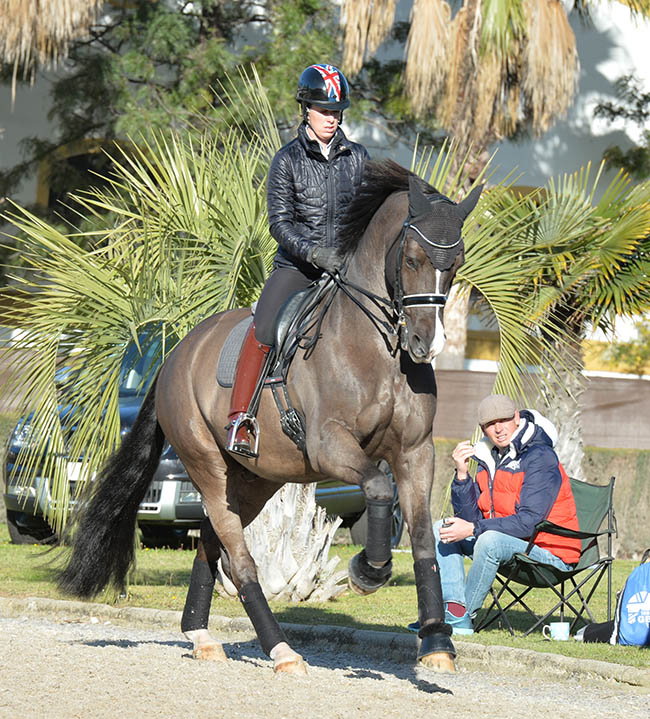
Carl Hester, eyes on the ground for Charlotte
“Hans Heinrich Eisenbach, who I loved and I did films with him for one year, he always said, there are moments of happiness, and I just loved that expression. There are moments when you go WOW! No rider in the world can tell me that he can keep that for ten or fifteen minutes, it’s just a few moments when it happens. Okay there might be a Charlotte, but I think we think too much about the exceptional riders, and not so much about the ordinary riders with their ordinary horses. The upper people we can help a little bit, but I think it is important to give a helping hand to the riders who are battling with the basics.”
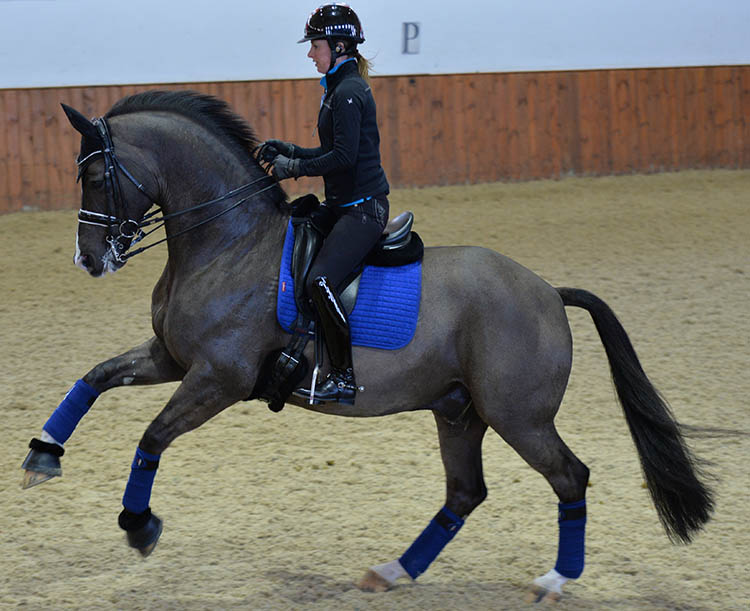
“Even the amateur who doesn’t know so much, can look at Charlotte and know that she is something special. In all my seminars as part of my theory session, I always say, I have not seen a rolkur-ridden horse, where the rider could really sit in the horse, especially in the medium and the extended, they either sit behind or they stand up in the saddle. I did some test riding in Ermelo, and they have special saddles with knee rolls like in the Middle Ages.”
But why do it like that when it is so much more comfortable and fun to do it correctly?
“Because they get all the money and the medals. There was a misunderstanding from too many people in our sport.”
Is that because we have judges who can’t see tension and bad riding?
“First of all, I think it has gotten much better. The riding is better, the judging is better but there is something else happening. I did an auction here for five years, and I still think it was a very clever idea. Our advertising had the message – do you want a horse that is really supple? A horse that is working on the training scale, a horse that is turned out every day, it was a different concept of preparing horses to sell. So many people came to look, Balkenhol, Bechtolsheimer, Nadine Capellmann, they were all here. Our horses were doing fabulous things for maybe half a minute, then we would put them away. And they said ‘great’ but at the end of the day, most of these customers went off to those auctions where the horses did twenty rounds of the arena at extended trot.”
“It has a little bit to do with us as human beings, we always think that for our money, we should get the best right now, and they don’t have the deep understanding, what can I develop over the years? It’s not only the judges, not only the riding, but now there is so much money in our sport that I think, unfortunately, it separates between the recreational riders who do the little local shows for fun, and then you have the riders who will buy a horse for eleven million – unbelievable!”
“The sport splitting. When I go to Junior / Young Rider shows, you won’t believe it, there are trucks that cost €700 / 800,000, there are horses that cost €200 / 300,000, the young riders don’t really go to school, all they do is partying and riding. It’s getting sick.”
Susanne’s musings about the world of dressage have a familiar ring, they are very like the great George Morris’ warnings about the direction showjumping is taking, and not surprisingly, Susanne is a George fan…
“Anja and I were about the only Germans who went to the Global Dressage forum, twelve months ago at Bartels Academy. We said we have to go there, even if it is very Dutch oriented, we have to be in the scene, we have to listen to know what is going on. And the forum featured George Morris. He was wearing riding breeches when he stepped into the arena – 77 years old – I thought, maybe it’s just to show that he used to ride.”
more follows
Would you like to breed to one of the best stallions Europe can offer? Like Vivaldi? Or his son Vitalis? Or a selection of many more top stallions. Go to: www.ihb.com.au
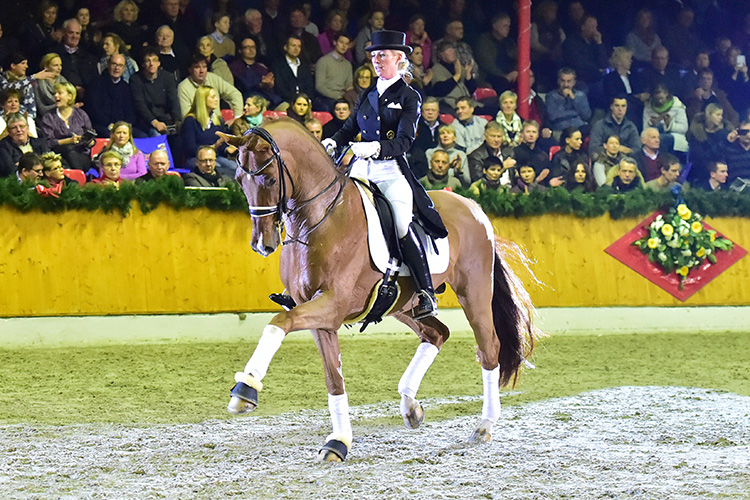
Vivaldi
“His topic was: Do You Think that the Classical Rules still Make Sense. First he talked about his life, and he is so funny, we were all giggling, then he called out – ‘where’s my horse?’ So he gets on the horse, and all he did, was legs mean go, and reins mean whoa. Where’s my fence? Make up my fence! Then he talked about balance, but nothing complicated. In a normal frame, a seven-year-old horse – Now I want to jump, guys get quicker, I want to jump… So perfect on the line, but only basic things, nothing complicated, and the horse just soared. No I want it higher, make it higher, this is chicken jumping… It was fabulous.”
“When he got off, he was asked by these mainly Dutch people, what does he think about the new development in dressage? He said, ‘what I never understood, because I really love horses, is why would I take the main instinct, the sight, why would I take that away from the horse? It doesn’t make any sense.’ And the Dutch were speechless. ‘Nooo we think like you, we always let our horse go long so they can see.’ It was ridiculous, he is such a great man.”
Susanne Miesner is not one of the legion embittered theorists who endlessly criticise real live riders and horses from the safety of their arm chairs. Susanne has produced champion young horses, and she has also competed at Grand Prix level. Her teenage daughter, Annabell, is already a successful jumping rider.

“It is really satisfying to me, that my daughter is internationally successful in jumping. At the age of eighteen she was selected by ‘Kaiser’ Johannsmann to ride on a video with Phillip Weishof and Toni Hassman – really good riders – because they said she is one of the few young jumping riders who can really ride a horse through, over the back. So we were really proud and this was my big goal over the last years to help make her not only a good jumping rider, but a good jumping horse trainer. It’s the same for jumping, dressage or eventing. You will see when I am training my bereiter, I am always watching the horse and watching the rider. You have to watch the pair.”
more for Susanne follows
And that is just what Susanne did after we had finished our interview. Susanne’s bereiter, Ann-Katrin Kulla was riding the six-year-old mare, Finess (Fidertanz / Romanov) and demonstrating Susanne’s logical and traditional approach to training.
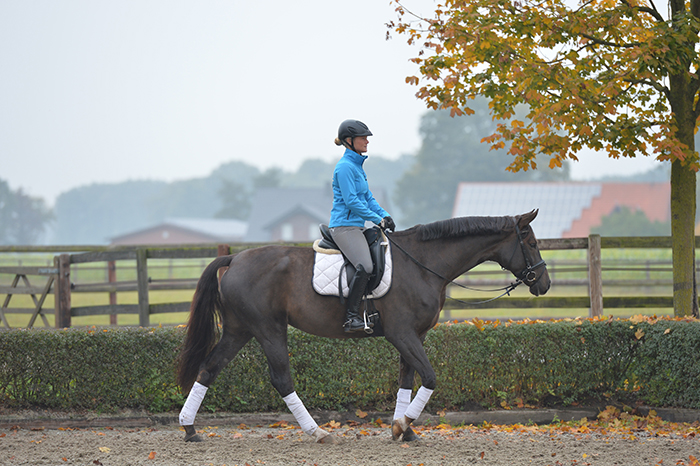
“When this mare came to me three months ago, she was already winning material classes – but it was all wrong. She looked great but she was not over the back, she was too light, not stepping into the hand. What we had to do is re-organize her balance. We had to get her to step into the connection, and then when she collects, she can go a bit lighter. We had to establish the flow from the hindlegs to the contact, and back again.”
“It doesn’t matter if a horse is three or thirteen, the most important thing is to walk on a loose rein. Then the horse really stretches over the withers, the muscles in the back stretch and become loose. That’s right Ann-Katrin, go right to the buckle. See, she is getting happier, her ears are coming forward.’
“Because she has not been trained 100% correctly, she has not got enough topline for her age, she has been trained to win classes, not to develop correctly. Ideally with a horse like this, the first fifteen minutes should be spent on stretching. Look at her topline, it is not bad, but it is not good. It is easy to see good, and it is easy to see bad.”
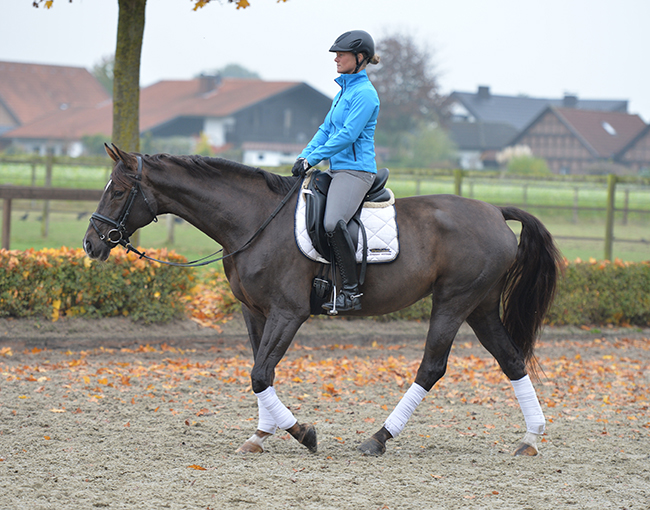
“In the loose rein stretching, it is not only for the horse – the riders warms up, look at Anna, she is a good rider, she has been with me for 17 years, she came as a 14-year-old, after two rounds, she moves more into the horse.”
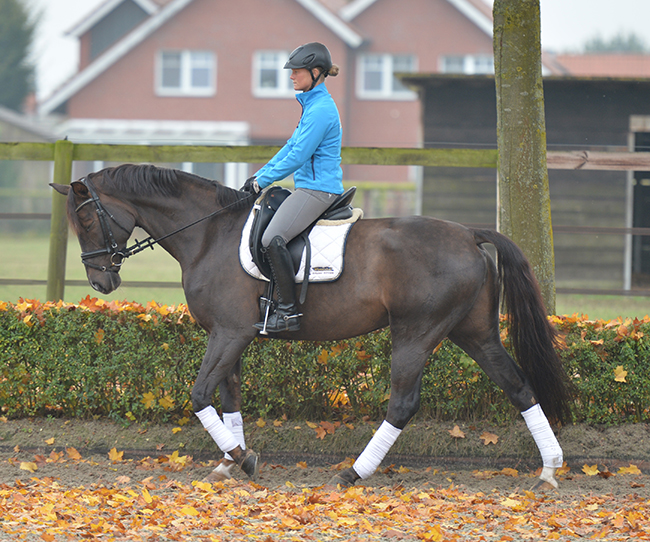
“We could start trot, but I want to see the connect behind to front through halts in walk. You can see she is too light in the hand, some people might think it looks perfect, but for me, it doesn’t look good. Anna must drive her and get more positive pressure in her hand – keep the connection, keep pushing but keep the connection. It is not about doing the perfect half halt, it is about getting the horse from behind into your hand. When you have some pressure on the rein, you are allowed to trot.”
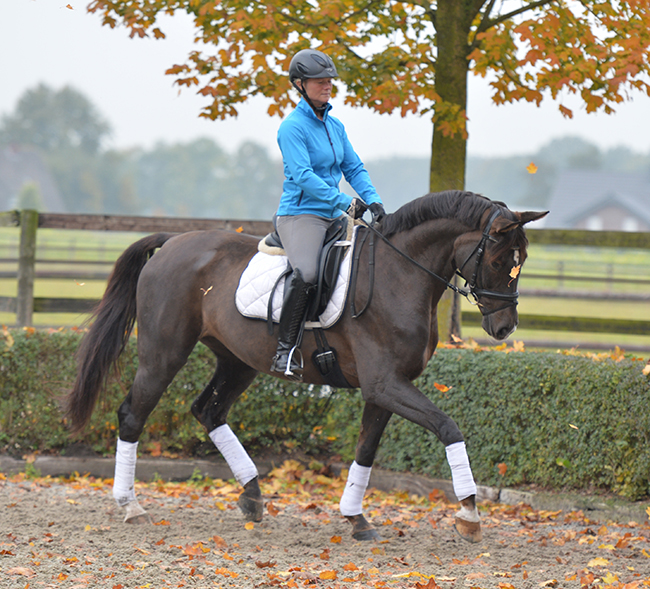
The work is the same in the trot, establishing an honest connection, putting the horse in balance:
“Concentrate on the transitions, forward and back, build the activity from behind. When Anna brings the horse slightly back, she still has to push her forward to the hand, you can keep riding as long as you can feel the hindlegs in your hand – and make your heel lower, we should always watch the horse AND the rider. When she is really into your hand then you can let go of the reins.”
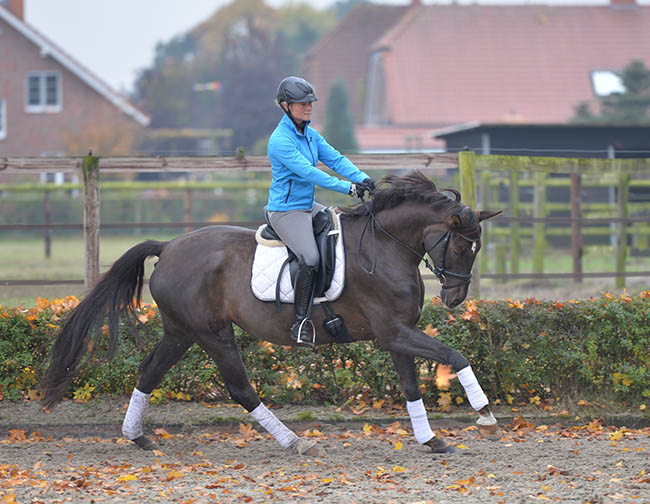
“Uberstreichen – that’s good, now get into half seat to relax the horse’s back.”
“It is working, the horse is searching for the connection. Now the rider can go forward with her hand, if she’d done that five minutes ago the horse would have lost balance. Now slip the rein all the way to the buckle to stretch the topline. There is a big difference between holding the horse down, and stretching down and completely loose, this way the horse has to find her own balance. Now you can see the topline coming up.”
“Paul Stecken used to say, if the horse is too light, you can give the rein for two rounds of the arena, not more. What Anna is doing now is like yoga, a full stretch.”

“Most trainers would have this horse in a double bridle, doing flying changes. I said to the owners, this winter we will concentrate on getting the balance right, then we can work again. The horse was so unhappy when she came here.”
“The sign of good training is when the horse is as long in front of the saddle as it is behind the saddle.”

“Give her a half halt, and remember a half halt is half of a halt…”
I don’t feel enough energy from her…
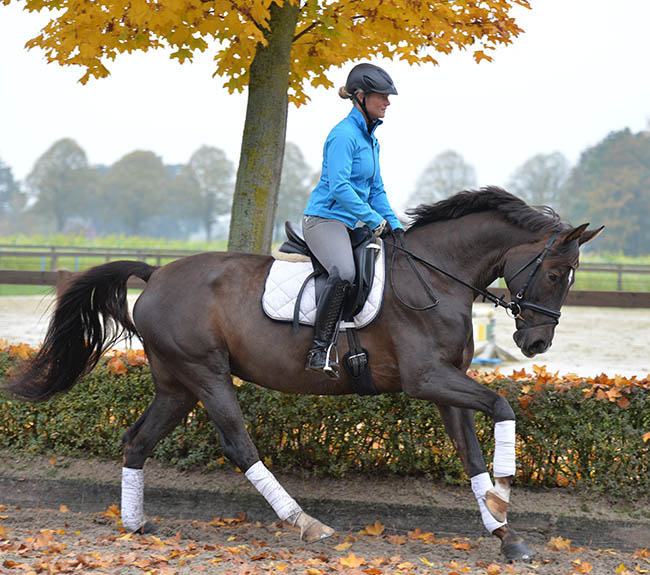
“No problems, give her a little kick and tell her she has to go forward. And use your trot / canter transitions to get the horse a little more between the aids. If I was prepared to settle for the mediocre, I would be happy, but the horse is not pulling enough through – go back to rising trot, I want to loosen the back muscles more. Of course we could try the alternative, sitting trot and two long whips, then she would do it, but she hasn’t got her balance yet, and won’t get it that way. Those things are no use, if you haven’t got the balance, she can do half pass, she can do counter canter, but first we have to get balance. I learnt from Fritz Tempelmann, good collection only comes through riding a horse forward.”
The dance goes on, day after day, and as long as we have thinking riders and coaches like Susanne, the principles will survive.
ENDS
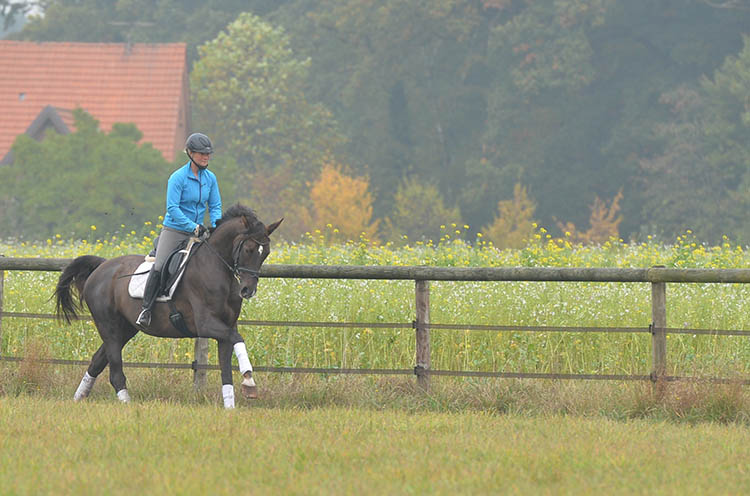
ADVERTISEMENT
Thinking about breeding a world class dressage horse? How about using Foundation, a performer himself, and a producer, for your mare? Go to the International Horse Breeders website now, and look for the perfect stallion for your mare, and look out for progeny by the stallions offered by International Horse Breeders, they are out there winning!
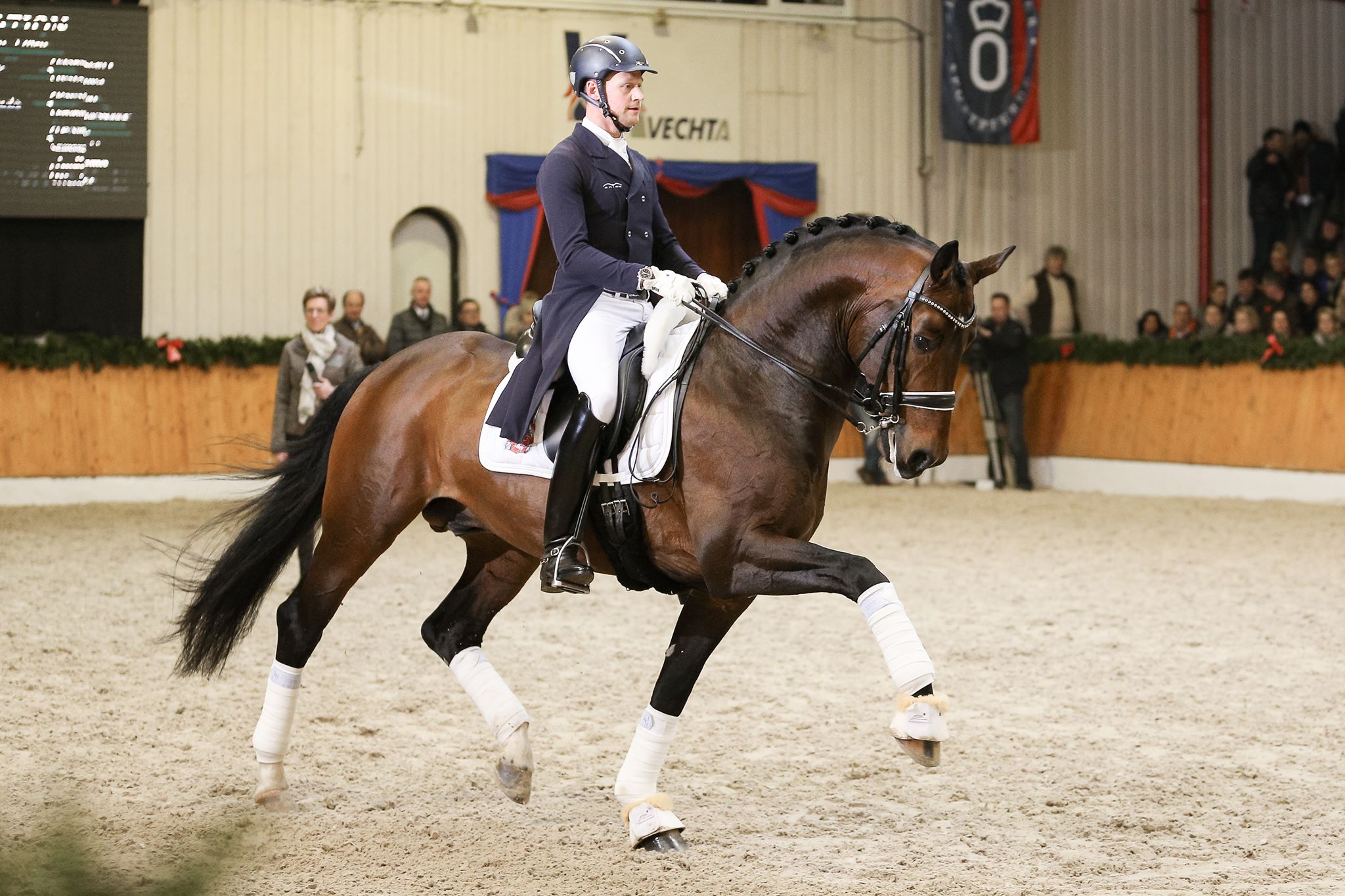
For more information ring Glenis on 03 5439 7251 or go to http://www.ihb.com.au



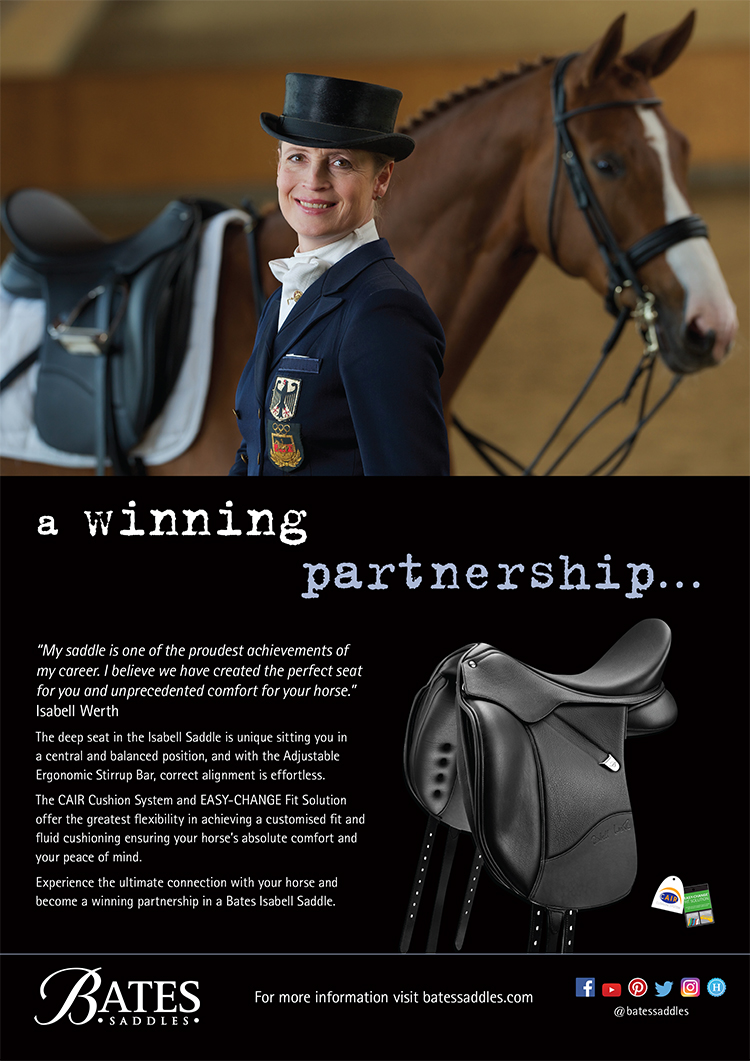
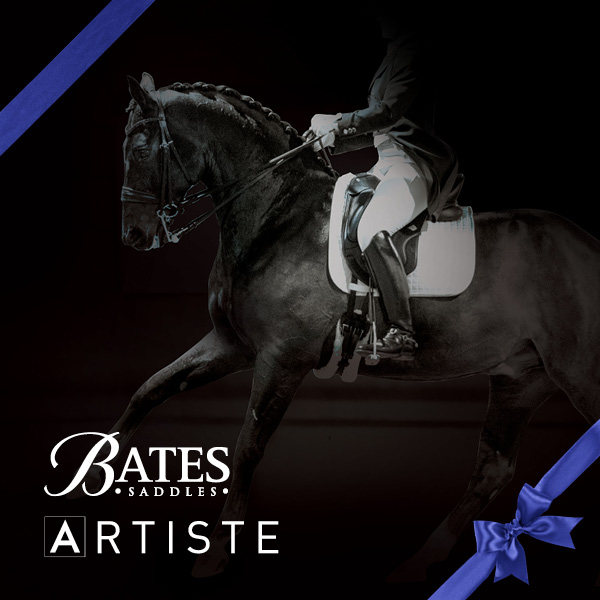

So many great realistic helpful messages in this interview. Will need to read it in parts and keep coming back to it. Thank you.
George Morris pops up everywhere. He is on a mission to make sure we keep to the correct principles for the horse.
thank you.for the article.
Super article thank you. Classical German dressage is about correct contact in conjunction with the training scale, not lack of contact as some “classical” theorists would have you believe.
Any person that says a Grand Prix test can be ridden without collection and win a gold medal, is just showing her jealousy. To say Anky van Grunsven has never trained true collection into her horses but still managed to ride fluent transitions in and out of piaffe, passage, canter pirouettes and extended canter is about as stupid as it gets. Sorry, but if you want to come across knowledgeable, don’t put down others. But I guess that’s the “German way”…..
Greetings from Los Angeles. I absolutely love this online magazine, we have nothing here that compares to the depth of these articles and interviews. I’d not heard of Susanne Miesner but loved this interview, will keep an eye out for clinics.
Excellent article, the biggest problem for most of us older people is the coaching and training time affordable to us due to work and family commitments. You can only get it right when taught through instruction/lessons and then the many subsequent hours spent practising to perfect. I would love to be able to ride like Carl, Charlotte or any of the other talented riders around. The reality is the rest of my riding years will be spent trying to learn to ride correctly with my horse and continue loving it.
Jenny Veenstra, The people should know what is right and what is wrong because not everyone sees it. I agree with this article. This is wonderful written.
Pity you couldn’t find a picture of Charlotte Dujardin riding a 3-beat canter. The lady with the light blue top appears to use a lot of spur.
Jess in Los Angeles: there is a trainer in Simi Valley near the Reagan Library who knows this way as described in this great article: Tenna Hansen.
Feeling inspired by this article. I do agree with the author’s views on Anky’s training and the reason I fault her as a trainer is that there was not the correct relationship between effort and relaxation, so well described her by Suzanne with words I cannot exactly recall – but where she talks about the bridge that is the connection – between the push and the relaxation lies suppleness in the horses and I always felt watching Ankyu that there was too much force, too much muscling through and up into a harsh hand connection, that I would get tense just watching it.